Hobbits At Harvard
Posted by: Loren Coleman on March 3rd, 2008
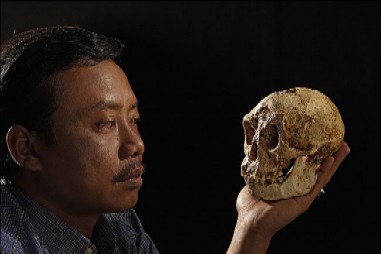
The discovery that Homo floresiensis survived until so very recently, in geological terms, makes it more likely that stories of other mythical, human-like creatures such as Yetis are founded on grains of truth….Now, cryptozoology, the study of such fabulous creatures, can come in from the cold.Henry Gee, editor of Nature, “Flores, God and Cryptozoology,” 2004 editorial.
This Thursday, March 6, 2008, at 5:30 pm, an intriguing lecture will occur regarding Homo floresiensis. I was first alerted to this forthcoming talk by my son, Malcolm, who is enrolled in Dr. Javier Urcid’s “Human Origins” course at Brandeis University.
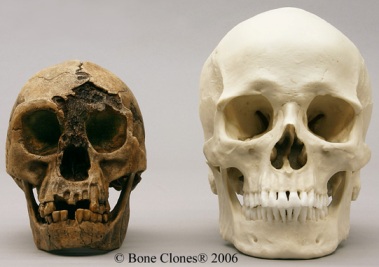
I have written on the topic often. Due to the fact I was an early correspondent with the Homo floresiensis discoverers regarding the exclusive dissemination of news of their findings, their arguments and their publications, I may travel from Maine to attend (depending on the weather). Having been given the first American replica of the Homo floresiensis skull replica to display on a national talk show in Los Angeles, late in 2005, I continue to feel the dynamic understandings forthcoming from this discovery have yet to be fully realized.
Certainly, for Boston area readers of my blog who are interested students of the passionate pursuit of the so-called “Hobbits”, you might consider this week’s talk a worthy lecture to add to your schedule.
Details of the event are these:

“Hobbits in the Haystack: Homo floresiensis and Human Evolution.” Lecture.
William L. Jungers, Professor, Department of Anatomical Sciences, Stony Brook University, School of Medicine.
Lecture co-sponsored by the Leakey Foundation.
The Peabody Museum of Archaeology and Ethnology at Harvard will host a lecture about how the fossils of the small-bodied, small-brained species Homo floresiensis are challenging our understanding of evolution. At 5:30 p.m., in the Geological Lecture Hall, 24 Oxford St., Cambridge, Massachusetts.
Doing a bit of research on the lecturer and his work, here is further background:

Professor Jungers examines the actual bones of Homo floresiensis while in Indonesia in 2007.
Dr. William Jungers is a Professor of Anatomical Sciences at Stony Brook University and he has been on the forefront of the research and debate surrounding the Homo floresiensis discovery.
Considered among the best evolutionary morphologists in the world, Dr. Jungers has traveled to the far corners of the globe investigating the function and structure of living and fossil primates. His research focuses on the evolution of human locomotion, body size, and biomechanical scaling, and vertebrate paleontology. He is also part of an international team involved in the analysis of the Homo floresiensis fossils from Indonesia. The original discoverers of the “Hobbit” fossil contacted Dr. Jungers and his colleague, Dr. Susan Larson, to help them understand the functional significance of the odd skeletons.
Dr. Jungers is the former editor of the Journal of Human Evolution and has authored more than 100 scientific articles and edited or co-authored several books, most recently Reconstructing Behavior in the Primate Fossil Record (2002). He received two major grants in 2006 to further his research on evolution, one from the Leakey Foundation and the other from the National Geographic Society.
A member of the American Association of Physical Anthropologists and the Paleoanthropology Society, Dr. Jungers received his Ph.D. in Biological Anthropology from the University of Michigan at Ann Arbor in 1976.
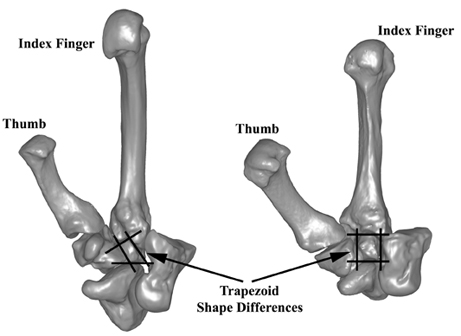
A comparison of wrist bones like those found in the Homo floresiensis (left) and those of a modern human suggest that the diminutive hominin is a unique species, Jungers and others said in their 2007 paper. Image courtesy of Science.
Dr. Jungers is one of the coauthors of the paper, “The Primitive Wrist of Homo floresiensis and Its Implications for Hominin Evolution,” in Science 21 September 2007: Vol. 317. no. 5845, pp. 1743 – 1745.
As Jungers and his colleagues noted in that article:
Each is well preserved and shows no signs of pathology or abnormal development. . . . [T]hese three articulating bones display none of the shared, derived features of modern human and Neandertal carpals. Instead, they show the general symplesiomorphic pattern exhibited by all extant African apes, as well as fossil hominins that preserve comparable wrist morphology and date before 1.7 Ma.

Evolving in isolation, Homo floresiensis present a unique anatomical package of primitive and derived features that suggests either surprisingly ancient ancestry or evolutionary reversals. Their body design has never been observed in modern humans, including the smallest people on Earth.
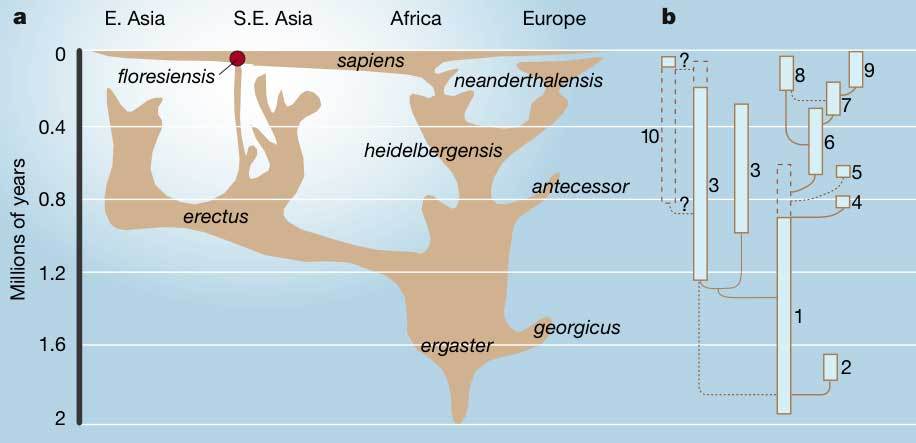
Tools and fire were made with primitive hands and a chimpanzee-sized brain. Just over a meter tall and robustly built, they walked bipedally on short hind-limbs that sported long feet. Jungers will address why attempts to dismiss the hobbits as Asian pygmies are misguided, but perhaps expected.

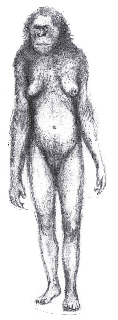
The male National Geographic painting of the first Homo foresiensis find, compared to Professor Richard Klyver’s sketch of the Flores woman. The first fossil discovery of Homo floresiensis was of a female, not a male.
About Loren Coleman
Loren Coleman is one of the world’s leading cryptozoologists, some say “the” leading living cryptozoologist. Certainly, he is acknowledged as the current living American researcher and writer who has most popularized cryptozoology in the late 20th and early 21st centuries.
Starting his fieldwork and investigations in 1960, after traveling and trekking extensively in pursuit of cryptozoological mysteries, Coleman began writing to share his experiences in 1969. An honorary member of Ivan T. Sanderson’s Society for the Investigation of the Unexplained in the 1970s, Coleman has been bestowed with similar honorary memberships of the North Idaho College Cryptozoology Club in 1983, and in subsequent years, that of the British Columbia Scientific Cryptozoology Club, CryptoSafari International, and other international organizations. He was also a Life Member and Benefactor of the International Society of Cryptozoology (now-defunct).
Loren Coleman’s daily blog, as a member of the Cryptomundo Team, served as an ongoing avenue of communication for the ever-growing body of cryptozoo news from 2005 through 2013. He returned as an infrequent contributor beginning Halloween week of 2015.
Coleman is the founder in 2003, and current director of the International Cryptozoology Museum in Portland, Maine.










Looking forward to your report on the lecture. Perhaps in the near future more specimens of Homo floresiensis will be discovered and some DNA recovered.
I would so love to attend this lecture. Please critique it for us on your return, Loren. Thanks
A very interesting topic and I’m sure the presentation will be great. Please keep us up to date on this, Loren.
My reading suggests that researchers are quietly but diligently and seriously (now that financial support is being directed at what is hoped to be a fruitful endeavor) examing a number of other similar caves on Flores and adjacent islands. I sense a great deal of anticipation in this and hope to hear more in the near future.
Paleoanthropology, long the subject of boring speculation about dust dry skulls and the lifestyle of cavemen as determined by fragments of ancient teeth is emerging with new relevance as we see the connection to our own place in the natural scheme of things. Cheers.
PS…what’s the deal with the Indonesian Gov’t’s official office of old stuff mishandling the original?
Dogu4- Yeah, it’s a shame that this topic is seen as so boring to a lot of people. I for one have never been bored by this stuff and Paleoanthropology has always been a subject that I’d like to get around to studying up on. The evolution of human locomotion, biomechanics, and physiology is something I’d really like to learn more about. Since I am quite fascinated in the evolution and ecology of island habitats, I find it very interesting that Homo floresiensis lived in such an environment and evolved so uniquely as a result.